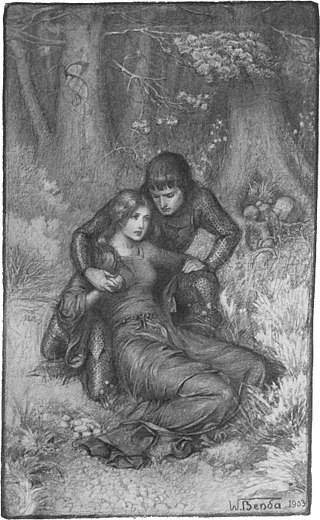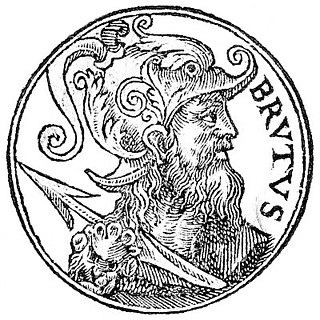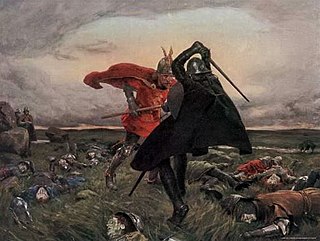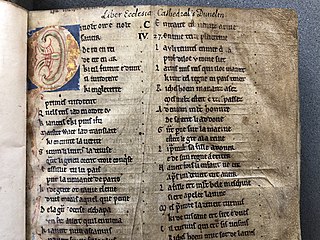Related Research Articles

Geoffrey of Monmouth was a Catholic cleric from Monmouth, Wales, and one of the major figures in the development of British historiography and the popularity of tales of King Arthur. He is best known for his chronicle The History of the Kings of Britain which was widely popular in its day, being translated into other languages from its original Latin. It was given historical credence well into the 16th century, but is now considered historically unreliable.
Layamon or Laghamon – spelled Laȝamon or Laȝamonn in his time, occasionally written Lawman – was an English poet of the late 12th/early 13th century and author of the Brut, a notable work that was the first to present the legends of Arthur and the Knights of the Round Table in English poetry.

In the Matter of Britain, Igraine is the mother of King Arthur. Igraine is also known in Latin as Igerna, in Welsh as Eigr, in French as Ygraine, in Le Morte d'Arthur as Ygrayne—often modernised as Igraine or Igreine—and in Parzival as Arnive. She becomes the wife of Uther Pendragon, after the death of her first husband, Gorlois.

Brutus, also called Brute of Troy, is a legendary descendant of the Trojan hero Aeneas, known in medieval British legend as the eponymous founder and first king of Britain. This legend first appears in the Historia Brittonum, an anonymous 9th-century historical compilation to which commentary was added by Nennius, but is best known from the account given by the 12th-century chronicler Geoffrey of Monmouth in his Historia Regum Britanniae.

Lud, according to Geoffrey of Monmouth's legendary History of the Kings of Britain and related medieval texts, was a king of Britain in pre-Roman times who founded London and was buried at Ludgate. He was the eldest son of Geoffrey's King Heli, and succeeded his father to the throne. He was succeeded, in turn, by his brother Caswallon. Lud may be connected with the Welsh mythological figure Lludd Llaw Eraint, earlier Nudd Llaw Eraint, cognate with the Irish Nuada Airgetlám, a king of the Tuatha Dé Danann, and the Brittonic god Nodens. However, he was a separate figure in Welsh tradition and is usually treated as such.

The Battle of Camlann is the legendary final battle of King Arthur, in which Arthur either died or was fatally wounded while fighting either alongside or against Mordred, who also perished. The original legend of Camlann, inspired by a purportedly historical event said to have taken place in the early 6th-century Britain, appears only in vague mentions found in several medieval Welsh texts dating since around the 10th century. The battle's much more detailed depictions have emerged since the 12th century, generally based on that of a catastrophic conflict described in the pseudo-chronicle Historia Regum Britanniae. The further greatly embellished variants originate from the later French chivalric romance tradition, in which it became known as the Battle of Salisbury, and include the 15th-century telling in Le Morte d'Arthur that remains popular today.
Archgallo was a legendary king of the Britons as recounted by Geoffrey of Monmouth. He ruled from 339BC. He was the second son of King Morvidus and brother of Gorbonianus.
Elidurus the Dutiful was a legendary king of the Britons as recounted by Geoffrey of Monmouth. He reigned in the late fourth century BC. He was the third son of King Morvidus and brother of Gorbonianus, Archgallo, Ingenius, and Peredurus.
Nennius is a mythical prince of Britain at the time of Julius Caesar's invasions of Britain. His story appears in Geoffrey of Monmouth's History of the Kings of Britain (1136), a work whose contents are now considered largely fictional. In Middle Welsh versions of Geoffrey's Historia he was called Nynniaw.

Historia regum Britanniae, originally called De gestis Britonum, is a pseudohistorical account of British history, written around 1136 by Geoffrey of Monmouth. It chronicles the lives of the kings of the Britons over the course of two thousand years, beginning with the Trojans founding the British nation and continuing until the Anglo-Saxons assumed control of much of Britain around the 7th century. It is one of the central pieces of the Matter of Britain.
Gorbonianus was a legendary king of the Britons as recounted by Geoffrey of Monmouth. He came to power in 349BC. He was the eldest son of King Morvidus, and the brother of Archgallo, Elidurus, Ingenius, and Peredurus.
Peredurus is a legendary king of the Britons in Geoffrey of Monmouth's pseudohistorical chronicle Historia Regum Britanniae. According to Geoffrey, he was the youngest son of King Morvidus and brother of Gorbonianus, Archgallo, Elidurus, and Ingenius.
Aurelius Conanus or Aurelius Caninus was a Brittonic king in 6th-century sub-Roman Britain. The only certain historical record of him is in the writings of his contemporary Gildas, who excoriates him as a tyrant. However, he may be identified with one of the several similarly named figures active in Britain during this period. In the 12th century Geoffrey of Monmouth adapted Gildas' account for his chronicle Historia Regum Britanniae, and thereafter Aurelius Conanus was remembered as a legendary King of Britain.
Cador is a legendary Duke of Cornwall, known chiefly through Geoffrey of Monmouth's pseudohistorical Historia Regum Britanniae and previous manuscript sources such as the Life of Carantoc. In Welsh genealogical records, he appears as Cado (Cadwr), the son of Cornish king Geraint. Early sources present him as a relative of King Arthur, though the details of their kinship are usually left unspecified.

The Brut or Roman de Brut by the poet Wace is a loose and expanded translation in almost 15,000 lines of Norman-French verse of Geoffrey of Monmouth's Latin History of the Kings of Britain. It was formerly known as the Brut d'Engleterre or Roman des Rois d'Angleterre, though Wace's own name for it was the Geste des Bretons, or Deeds of the Britons. Its genre is equivocal, being more than a chronicle but not quite a fully-fledged romance.
Layamon's Brut, also known as The Chronicle of Britain, is a Middle English alliterative verse poem compiled and recast by the English priest Layamon. Layamon's Brut is 16,096 lines long and narrates a fictionalized version of the history of Britain up to the Early Middle Ages. It is the first work of history written in English since the Anglo-Saxon Chronicle. Named for Britain's mythical founder, Brutus of Troy, the poem is largely based on the Anglo-Norman French Roman de Brut by Wace, which is in turn a version of Geoffrey of Monmouth's Latin Historia Regum Britanniae. Layamon's poem, however, is longer than both and includes an enlarged section on the life and exploits of King Arthur. It is written in the alliterative verse style commonly used in Middle English poetry by rhyming chroniclers, the two halves of the alliterative lines being often linked by rhyme as well as by alliteration.
Pridwen was, according to the 12th-century writer Geoffrey of Monmouth, King Arthur's shield; it was adorned with an image of the Virgin Mary. Geoffrey's description of it draws on earlier Welsh traditions found in Preiddeu Annwfn, Culhwch and Olwen, and the Historia Brittonum. The shield is also named and described by Wace, Layamon, Roger of Wendover and Robert of Gloucester among other medieval writers, and it directly inspired the description of Sir Gawain's shield in Sir Gawain and the Green Knight.

Brut y Brenhinedd is a collection of variant Middle Welsh versions of Geoffrey of Monmouth's Latin Historia Regum Britanniae. About 60 versions survive, with the earliest dating to the mid-13th century. Adaptations of Geoffrey's Historia were extremely popular throughout Western Europe during the Middle Ages, but the Brut proved especially influential in medieval Wales, where it was largely regarded as an accurate account of the early history of the Celtic Britons.

Gogmagog was a legendary giant in Welsh and later English mythology. According to Geoffrey of Monmouth's Historia Regum Britanniae, he was a giant inhabitant of Albion, thrown off a cliff during a wrestling match with Corineus. Gogmagog was the last of the Giants found by Brutus and his men inhabiting the land of Albion.
Rhongomyniad, or Rhongomiant, was the spear of King Arthur in the Welsh Arthurian legends. Unlike Arthur’s two other weapons, his sword Caledfwlch and his dagger Carnwennan, Rhongomyniad has no apparent magical powers.